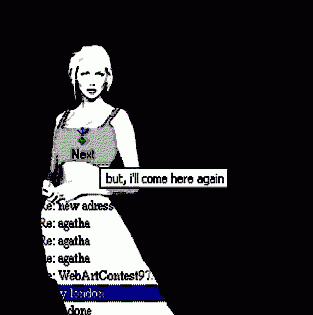
INCCA affiliated project
Restoration Project: Olia Lialina’s early net.art piece “Agatha Appears” from the Collection of C³ Center for Culture & Communication Foundation
ART WORK INFO
Author: Olia Lialina (C3 Residency Program); Márton Fernezelyi (Programmer)
Title: Agatha Appears
Created: 1997
Type: Interactive resource, net based art
Available: www.c3.hu/collection/agatha/
Format: HTML (included: ram, gif files)
Abstract: The work presents the dialogue between a system administrator and Agatha, the lost country girl. Lialina investigates nature of new art medium, through her hypertext-narratives which use the non-linear and decentralized structures of the Net.
Related resources: http://www.nettime.org/Lists-Archives/nettime-l-0108/msg00098.html
PRESERVATION INFO
Conservator: Elzbieta Wysocka
Programmer: András Sz?nyi
Organization: Center for Culture & Communication Foundation in Budapest http://www.c3.hu/
Date: January – October 2008
ABSTRACT
State of the artwork before the restoration.
Work was originally created for Netscape 4.0 browser in HTML 3.2 language and real audio sound format. Original files have become incompatible with contemporary browsers and work was no longer available in its previous, interactive form.
Due to corruption and disappearance of some files, sections of Agatha's trajectory got lost and so was the original idea of the piece.
Outcome of the project
The outcome of the preservation project is the re-establishment of the original visual effect intended by the author through restoration of the proper functioning of Agatha Appears. It was decided that a higher priority should be given to maintaining easy online access and the work’s correct functioning on modern browsers than to preserving the author's programming, through virtualisation of the artwork’s environment. A consequence of this decision was the compilation of a handful of strategies needed for this kind of complex Net-art object. Generally, objects ‘migrate’ to modern technologies and so a part of the files was reformatted to valid formats and non-functioning lines of code were reprogrammed according to new HTML standards. If a simple change was not possible, a more developed script was used to mimic the behaviour of obsolete code. We may say this is a kind of reinterpretation of the author’s idea using today's language possibilities. The decision to recreate a path with the new version was a consequence of the preservation strategy undertaken and kind of “re-interpretation”.
Although Agatha is complete again and works properly with current browsers, applied conservation treatments won’t protect Net-art pieces from further Internet development as it is barely possible to predict these transformations. Reformatting and reprogramming strategies are not long-term solutions because they place the artwork in a never-ending process of continuous translation to correlate with valid technology. For this reason and due to the nature of the medium itself the results obtained cannot be considered the final state of the work and the end of preservation efforts. How long these changes of source code will be compatible is difficult to predict, but it seems probable that after standardisation of HTML, it should not require significant changes for quite some time. At the same time the development of interfaces and the operations of browsers won’t be slowed by the extremely rapid development of the communications technology sector. Perhaps in the distant future only emulation will provide the opportunity to present this work. We can clearly see a dilemma which soon all contemporary art museums will need to face: how can one save the source material (i.e. encoding files) in a world of constant technological development and how does one preserve on-line art? How can the role of the network environment be assessed for a particular work of art and how can its constant change of artwork context be dealt with?
Since the problem will continue to grow we may assume that soon there will be no easy and unquestionable solutions…
For further reading and more information about project see the downloadable full text.
For questions or comments, please contact:
Elzbieta Wysocka, e-mail: ela-wysocka@o2.pl